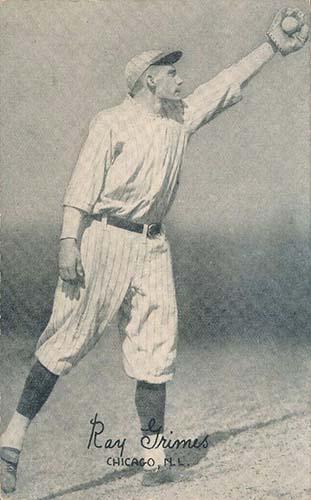July 23, 1922: Cubs’ Ray Grimes set consecutive-games RBI record — and nobody noticed for decades
 Imagine setting a baseball record that has stood for over a hundred years and never even knowing you had set it. Such was the case for Oscar Ray Grimes, Sr. (You can call him Ray.)
Imagine setting a baseball record that has stood for over a hundred years and never even knowing you had set it. Such was the case for Oscar Ray Grimes, Sr. (You can call him Ray.)
It was 1922. In many ways, the game of baseball was the same as in the twenty-first century. The bases were still 90 feet apart; the pitcher’s rubber was still 60 feet 6 inches from a home plate that was still 17 inches wide. There were umpires, but only two of them per game.
Yet, many aspects of the game were different. Every game was a day game. Most games were under two hours in length. Newspapers were the primary source for game information. Road trips lasted for weeks. Travel was mainly by rail. The Brooklyn baseball team was known as the Robins. The Chicago Cubs were still the Cubs, but in 1922 many newspapers called them the Bears.1
It was July 23, 1922, a midsummer’s afternoon. As best as can be surmised, it was a typical warm July day in Chicago with temperatures in the 80s, cooler near Lake Michigan.2
The Sunday game started at 3:00 P.M. According to the Chicago Tribune, “Fully 15,000 cash customers turned out for their final peek at the Cubs for three weeks.”3 It was the rubber game of a five-game series, with the Cubs and Robins swapping wins for the first four games.
The Cubs had been home since July 7 and were finishing an 18-game homestand at their eight-year-old ballpark on the North Side of Chicago then known as Cubs Park.4 They were tied with the Cincinnati Reds for third in the National League, 8½ games behind the first-place St. Louis Cardinals.
With the exception of a Sunday makeup game in Brooklyn, the Robins had been on the road since July 3.5 After this game, they were returning home to Ebbets Field in the Flatbush neighborhood of Brooklyn. They were tied with the Pittsburgh Pirates for fifth place, 11½ games back of the Cardinals.
Grimes, a 28-year-old Ohio native, was in his second season as the Cubs’ starting first baseman. On June 27, in the second game of a doubleheader with the Pirates, Grimes drove in a run with a fifth-inning single against Whitey Glazner. He sat out the next day’s game because of lower back pain – the first game he had missed all season – and then drove in at least one run in each of the next nine games.6
An RBI single against the Boston Braves in the second game of a July 8 doubleheader made it 11 straight games with an RBI, but Grimes injured his back and had to leave the game.7 The injury sidelined Grimes for the next nine games, but he resumed his pace when he returned, homering and driving in two runs against the Philadelphia Phillies on July 18.8
Grimes then drove in runs in the first four games of the Brooklyn series to push his streak to 16 games. He was batting .444 with a .730 slugging percentage, 2 homers and 25 RBIs during that time.
In the series finale, the Robins drew blood in their first at-bat against Cubs hurler Vic Aldridge, who had won four straight decisions to set his season record at 12-8. With one out, Hy Myers singled to right field. Tommy Griffith then beat out a slow roller to first base. When Grimes flipped late to Aldridge, who had rushed over to cover the bag, an alert Myers scampered to third base. Griffith stood safely on first.9
Zack Wheat then grounded out to Zeb Terry at second base, allowing Myers to score the first run of the game. Griffith advanced to second. Clarence Mitchell walked, but Andy High grounded to first base; this time Grimes tagged the bag himself for the unassisted third out. Brooklyn rookie right-hander Harry Shriver retired the Cubs in order, and when the first inning ended, the Robins led 1-0.
That lead was short-lived. Grimes led off the bottom of the second inning with a monster opposite-field home run over the right-field wall, his ninth homer of the season. According to Frank Schreiber of the Chicago Tribune, “The pill cleared the bricks by eight feet in right center and tied the score.”10 The home run made it the 17th consecutive game in which Ray Grimes had driven in a run.
After two innings, the game was knotted at 1-1. It remained tied as Aldridge retired the Robins without further incident through the top of the fifth inning. Meanwhile, after the Grimes bomb, Shriver successfully navigated through the Cubs lineup in the third inning but was lucky to survive a rocky fourth inning unscored on when he had loaded the bases.
In the bottom of the fifth, Shriver’s luck wore off. The inning started innocently enough, as Aldridge grounded out to shortstop. Then the hit parade started. Cliff Heathcote shot a single to left. Charlie Hollocher bunted to move Heathcote along but beat the throw and ended up safe on first base while Heathcote claimed second. Terry followed with a single to center field, scoring Heathcote and moving Hollocher to third.
After three successive singles, Shriver threw a wild pitch that advanced Terry to second base.
Grimes then launched a fly ball to center field that scored Hollocher from third for his second RBI of the game. Turner Barber singled, moving Terry to third base. Terry scored on a passed ball to pad the Cubs’ lead. When the dust settled, it was Cubs 4, Robins 1 after five innings.
Aldridge breezed, retiring the Robins in order in the sixth, seventh, and eighth innings. He had to dig deeper in the ninth inning, facing five batters and yielding a walk and a single. But no Robin touched the plate. The Cubs won, 4-1.
While the Cubs sent a dozen batters to the plate in the sixth, seventh, and eighth innings, they scored no more runs. As it turned out, it didn’t matter. The Cubs wouldn’t even need their ninth inning raps.
The 18-game homestand ended. Beginning on July 7 and ending July 23, the Cubs won 12 games and lost just 6 to maintain their hold on third place in the NL.11 As was the custom in 1922, the Cubs immediately left the ballpark and hit the rails to get to Boston for their next game. “Right after the Combat … the Cubs dashed for the depot in a flock of taxi cabs leaving at 6:30 PM on the New York Central for Boston,” observed the Chicago Tribune.12
None of the newspapers mentioned Grimes’ streak. Nobody noticed. Nobody knew nobody else ever had an RBI streak that long. Things like this were not tracked in 1922. Heck, RBI was not a recognized statistic until just two years prior in 1920 and even then, it was not included in many box scores, including the Chicago Tribune game account the next day.13
After a daylong eastbound trip across the heartland on the dusty rails, the Cubs arrived in Boston for a five-game series starting Tuesday, July 25. “Led by Manager [Bill Killefer] the hopeful Cubs galloped into this city tonight travel worn, and tired,” wrote the Chicago Tribune scribe, Schreiber.14 Such were the rigors of the baseball schedule in the 1920s.
It was there that Grimes’ RBI streak unceremoniously ended. Once again, nobody noticed. The streak was halted by the last-place team in the National League, the Braves. Granted, the Cubs won, 6-3, and Grimes walked, even scored a run. But, nary an RBI did he register.
He went on to finish second in the NL in batting average (.354), second in OPS (1.014),15 and fifth in RBIs (99). In more than a hundred years, nobody has eclipsed the record that nobody knew about in 1922.16
Author’s Note
A 1980 SABR Baseball Research Journal article by Seymour Siwoff details the discovery of Grimes’ RBI record for consecutive games. The feat was then acknowledged by the Elias Sports Bureau.
Ray Grimes died at the age of 59 on May 25, 1953, and went to his grave not knowing he had set a record for consecutive games with an RBI.
Acknowledgments
This article was fact-checked by Mike Huber and copy-edited by Len Levin.
Photo credit: Ray Grimes (Trading Card Database)
Sources
In addition to the sources cited in the Notes, the author consulted Baseball-Reference.com and Retrosheet.org for pertinent information, including the box score and play-by-play.
https://www.baseball-reference.com/boxes/CHN/CHN192207230.shtml
https://www.retrosheet.org/boxesetc/1922/B07230CHN1922.htm
Notes
1 At the start of the 1922 baseball season, there were no sports teams in Chicago named the Bears. The Chicago Staleys of the American Professional Football Association had moved from Decatur, Illinois, to Chicago in 1921. George Halas – briefly a member of the New York Yankees in 1919 – then changed the name to the Chicago Bears before the 1922 football season, which was also when the APFA rebranded itself as the National Football League.
2 “Official Weather Report,” Chicago Tribune. July 24, 1922: 7. According to the archives from a time before weather reports became sophisticated, the official reading reported in the daily print paper of the Chicago Tribune was done at 7 P.M.
3 Frank Schreiber, “Aldridge Hurls Cubs to Win over Robins,” Chicago Tribune, July 24, 1922: 15.
4 Born as Weeghman Park on April 23, 1914, the ballpark was renamed Cubs Park in 1920. The venue would then be named Wrigley Field in 1926. There were brick walls, but no vines. Those were planted in 1937.
5 The Robins’ 18-game road trip had an unscheduled hiatus on Sunday, July 16, as the Robins returned home to play a makeup game vs. the Pirates. A June 20 game that was canceled for wet grounds was replayed in Brooklyn that day. It made for an interesting trip on the rails as the Robins played Friday in Cincinnati, Saturday in Pittsburgh, Sunday in Brooklyn, back to Pittsburgh on Monday. There was at least a day off before traveling to Chicago on Wednesday for this five-game series.
6 The Chicago Tribune noted that a “mild attack of lumbago” kept Grimes on the bench. Frank Schreiber, “Pirates’ 18 Swats Defeat Cubs, 7 to 2,” Chicago Tribune, June 29, 1922: 16.
7 Frank Schreiber, “Cubs Grab Two Games from Lowly Braves, 6-5 and 8-2,” Chicago Tribune, July 9, 1922: 2, 2.
8 Schreiber, “Grimes Returns and Bats Cubs to 6-3 Victory.”
9 “Robins Stumble Into Sixth Place: Lose to Cubs as Western Tour Closes,” New York Times, July 24, 1922: 17.
10 Schreiber, “Aldridge Hurls Cubs to Win over Robins.”
11 The Cubs eventually ended up in fifth place, 13 games behind the champion New York Giants.
12 Schreiber, “Aldridge Hurls Cubs to win over Robins.”
13 “Aldridge Hurls Cubs to Win over Robins.” The box score makes no any reference to RBIs.
14 Frank Schreiber, “Cubs-Braves to Open Series in East Today,” Chicago Tribune. July 25, 1922: 15. The article further speaks to the road trip: “After the Boston series, come sets with Philadelphia Brooklyn, and New York.”
15 The OPS figure is retrospective. The statistic didn’t exist then.
16 In 2000 Mike Piazza of the New York Mets drove in runs in 15 consecutive games, the second-longest streak in National or American League history.
Additional Stats
Chicago Cubs 4
Brooklyn Robins 1
Cubs Park
Chicago, IL
Box Score + PBP:
Corrections? Additions?
If you can help us improve this game story, contact us.


